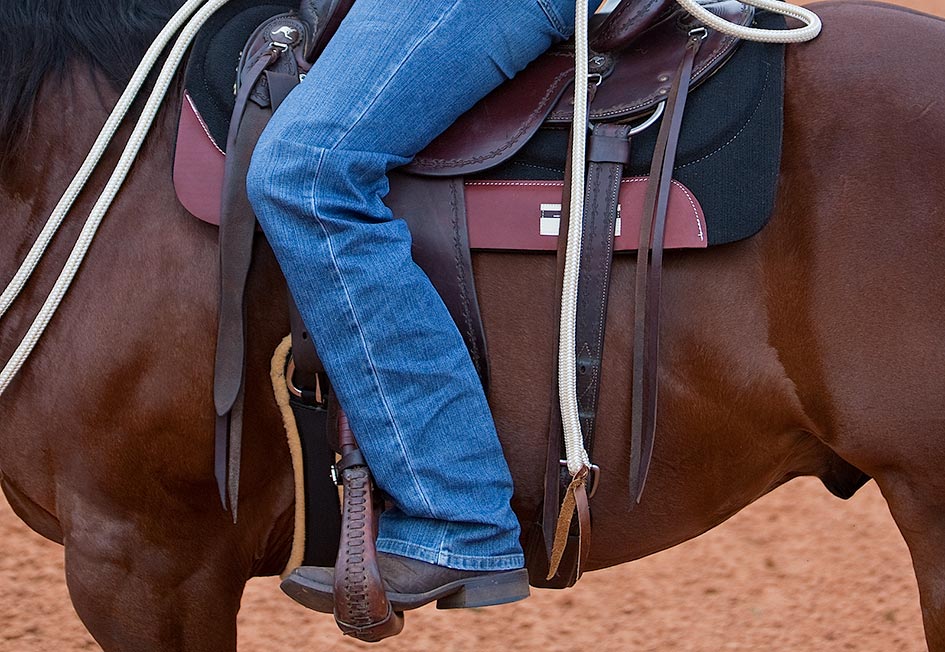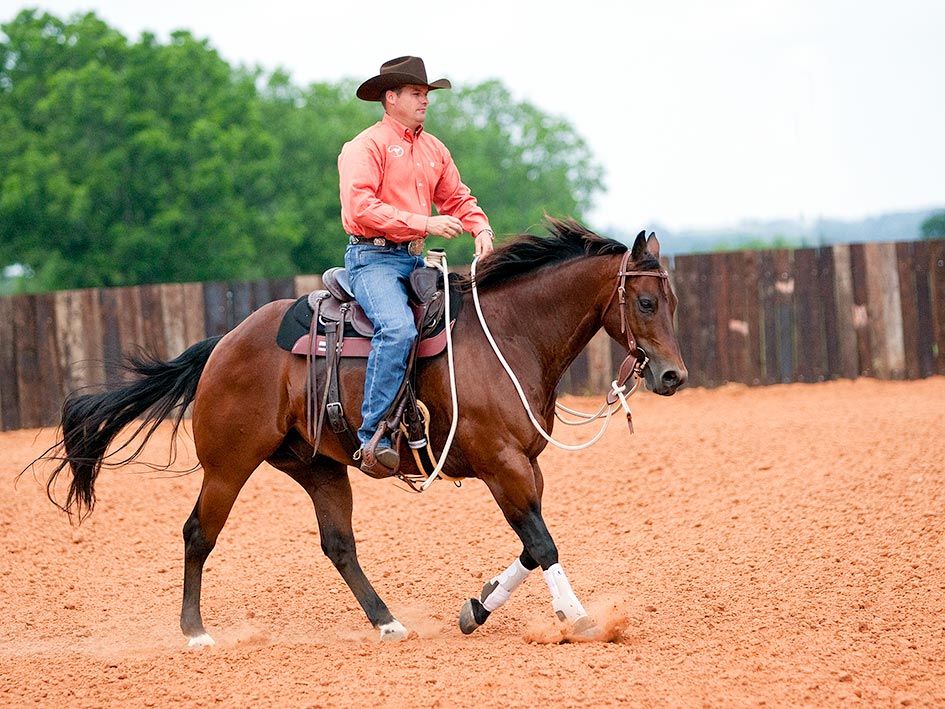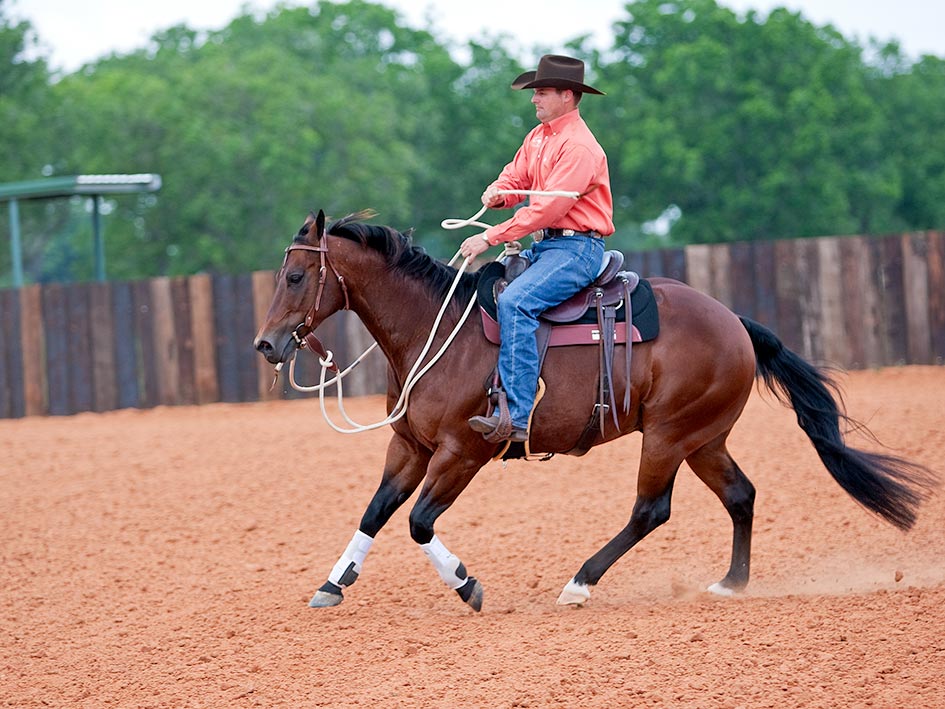Teach your horse to move forward off a feather-light cue.
Ever watch a really talented horseman ride where it looks like they’re barely moving in the saddle and their horse is responding to seemingly invisible cues? It’s as if the horse is reading the rider’s mind, and to some degree, that’s almost true. The horse has learned to read the subtlest of the rider’s body language.
The secret to getting your horse to respond to the slightest of cues is to establish a foundation of clear communication. The first step in training a horse is teaching him to move forward. My mentor Ian Francis always told me, “You can’t train a horse if he isn’t moving,” and that’s absolutely true. If you can’t get your horse to go forward, there isn’t a whole lot you can do with him. It’d be like having a Ferrari with no gas pedal; sure it’s nice to look at, but it’s absolutely useless.
In fact, I like to compare the basics of training a horse to building a car. First, you have to establish a gas pedal, which means the horse goes forward anytime you ask. Once you can move the horse forward at all three gaits (walk, trot and canter), then you establish a brake. Initially, we do this with the One Rein Stop and then advance to teaching the horse to stop off pressure from both reins, and eventually off just our voice. Once we have a gas pedal and brake, then we work on a cruise control button in which the horse maintains the gait and speed you set him in. Then we establish a steering wheel.
On a well-broke horse, you should be able to cue him to move forward, increase his speed or move to the next gait by lightly squeezing his sides with the calves of your legs. As soon as you apply pressure, he
should immediately respond.
Just like everything we do with horses, the teaching stage of training the horse to move forward off leg pressure looks nothing like the finished result on a well-broke horse, but in order to achieve that goal you’ve got to start with the basics. I teach horses to move forward off my leg cue with the Fundamentals exercises One Rein Stops and the Cruising Lesson. In both exercises, you teach the horse to move forward using three separate cues: Squeeze, cluck and spank.
Introduce the Concept
Horses are intelligent, but they are simple creatures and learn best when information is broken up into small steps. Keeping that in mind, when you teach your horse to move forward off your leg cue, that’s the only thing you’ll be working on—you won’t worry about steering the horse, asking him to collect, etc. You’ll only be working on establishing what I call the gas pedal.
To begin, find a safe, controlled area to practice in like an arena or pasture. Since you’ll be working only on establishing a gas pedal, you want to be in a safe environment where you can put the horse on a loose rein, so you’re not steering him, and not have to worry about where he goes.
You’ll introduce the cue at the walk, and then move up the gaits as the horse catches on to the lesson. Ask the horse to walk forward by squeezing the middle of his ribcage with both legs. Think of squeezing his sides with the same amount of pressure you’d use to firmly shake someone’s hand. Squeezing is politely asking the horse to go forward.
If he doesn’t immediately respond by walking forward, cluck two times with your tongue: “cluck, cluck.” Clucking warns the horse that he is about to feel uncomfortable if he doesn’t move. Continue to squeeze the horse’s sides with your legs as you cluck.
If he still doesn’t walk forward, spank him with the end of the mecate from side to side or use a dressage whip to tap him behind your leg. Again, you should still be squeezing the horse’s sides with your legs as you spank. In the beginning when you spank the horse, don’t start off by spanking him really hard. Just start out gently spanking from side to side. If the horse doesn’t respond, then gradually increase the pressure until he walks forward.
As soon as the horse walks forward, instantly release all the pressure—stop squeezing his sides, stop clucking and spanking. When the horse is going forward at the speed you want, your legs should hang loosely against his sides, not applying any pressure. It would be almost like if you were holding someone’s hand—you can feel the other person’s hand, but they’re not putting any pressure on you. A lot of people get confused at this point and ask how the horse knows to keep moving forward if you’ve removed your leg pressure. The answer is that’s what you’re teaching him to do—whenever you cue him to do something, he should continue to do that thing until you give him another cue. So if you cue him to walk forward, he should continue to walk forward until you either ask him to stop or cue him to go faster. You’re teaching your horse to be responsible for his own feet. You shouldn’t have to micromanage his every move; when you give him a cue, he should carry that direction out until you tell him otherwise.
That’s a hard concept for a lot of people to grasp because we human beings love to micromanage our horse’s feet. But if you want a truly well-broke, responsive horse, you need to teach him to be responsible for his own feet. When I worked for Ian, he told me that when you’re cueing the horse to do something, you always ask, insist and then enforce. Regardless of how you phrase it, the real goal is to ask with the least amount of pressure and then increase that pressure, until you get the response you are looking for. You start by giving the horse the lightest cue possible. In this case, you’re politely asking him to go forward off a gentle squeeze of your legs. If he ignores you, then insist that he goes forward. That’s where the cluck comes in. “Cluck, cluck—hey, I’m asking you to move your feet. If you don’t, you’re going to feel uncomfortable.” If the horse chooses to ignore you still, then you enforce your cue by spanking, gradually increasing the pressure until he responds. Always ask and then tell. One day when you ask him, there will be no need to tell him.
If a horse can feel a fly land on his hindquarters, he can certainly feel you squeezing with your legs. Even if you know the horse isn’t going to respond to just a gentle squeeze, always give him the benefit of the doubt by asking lightly. A horse will never get any lighter than the first amount of pressure you apply. If you always ask with the lightest amount of pressure, then increase the pressure as needed, over time all you’ll have to be is gentle. However, if you always ask the horse to move by spanking him or spurring him, you’ll always have to spank or spur him to get him to move.

To ask your horse to move forward, gently squeeze the middle of his ribcage with your legs.

When the horse is going forward at the speed you want, your legs should hang loosely against his sides, not applying any pressure.
Use Pressure Accordingly
If your horse is sensitive, he may move forward as soon as you squeeze his sides. That’s great! You don’t have to use cluck or spank. However, if he’s lazy and dull, you may have to spank firmly. A word of caution: you need to use some feel when spanking the horse. The more sensitive he is, the less you’ll have to spank. In fact, you may just have to wave the spanker back and forth to convince him to move his feet. The duller and lazier he is, the harder you’ll have to spank. You may have to spank him pretty firmly from side to side several times to get your point across. Do what you have to do to get the job done. Do it as easy as possible, but as firm as necessary.
In the beginning, if you have to spank the horse to get him to move, you may want to spank him on his shoulders, in front of your knees. Spanking behind your legs gets more forward motion, but lazier horses tend to resent it. They might kick out or do something disrespectful. If you feel confident in your seat, then there’s no problem spanking the horse behind your legs, but if you’re hesitant about your ability to stay in the saddle, spank the horse in front of your legs, on his shoulders.
Walk the horse forward 50 feet, and then stop him by doing a One Rein Stop. Sit deep in the saddle, slide one hand down the rein and pull it up to your hip. Hold the pressure until the horse stands still and softens his face. He should touch his nose to your boot, jeans, stirrup or fender before you release the rein.
Then ask him to walk off again using Squeeze, Cluck, Spank. If the horse responds by moving forward when you first gently squeeze his sides with your legs, there’s no need to cluck or spank. But if he doesn’t walk forward, then cluck two times, and then spank if he is still ignoring you. Practice walking the horse forward until he readily walks off as soon as you squeeze his sides with your legs. Then practice the same thing at the trot and the canter. Be prepared to spank if your horse leans toward the lazy end of the scale. The faster you ask him to move, the more resistance he’s likely to give you.

If you cue your horse to canter, he should canter until you tell him to stop or cue him to go faster. That means if you asked your horse to canter and you fell over dead and it took your neighbor three days to discover you, they should find your horse still cantering.
Hold the Pressure
Through the Cue Once you squeeze the horse with your legs to cue him forward, do not stop squeezing until he goes the speed you want. That means that you may be squeezing with your legs and clucking or spanking at the same time. You want the horse to associate squeezing with moving forward. If he doesn’t move off a gentle squeeze, then you’ll warn him by clucking, and then make him feel uncomfortable until he moves forward by spanking him.
A lot of people will squeeze with their legs, release the pressure, squeeze again, and then release, but that gives the horse mixed signals. Remember, horses learn from the release of pressure, not pressure itself. Every time you release the pressure it’s like you’re rewarding him for ignoring you, and before long when you apply leg pressure, it means nothing to him. If you have to cluck and spank, keep squeezing at the same time. As soon as he goes the speed you want, release the pressure. It’s his job to maintain the speed until you tell him otherwise.

If your horse is dull and lazy, you may have to spank him firmly in order to get his feet to move. Do what you have to do to get the job done. Do it as easy as possible, but as firm as necessary.
Nix the Kick
If you’ve watched one too many Westerns, you might be under the impression that kicking is the best way to cue the horse to go forward and move faster. While the cowboys on TV went for the kick, educated horsemen don’t. If your horse doesn’t move forward off a gentle squeeze from your legs and you’ve warned him to go forward by clucking, then spank him until he goes forward. Kicking shortens a horse’s stride and makes him tighten up, while spanking lengthens his stride. If you get in the habit of kicking the horse to go, you’ll always have to kick him and he’ll never learn to move forward off just a gentle squeeze.
Even if you have a lazy horse and you know he is going to ignore you when you gently squeeze his sides with your legs, always go through Squeeze, Cluck, Spank in order. If you squeeze and he doesn’t respond within a couple seconds, cluck. If he still doesn’t respond, then spank. If he still doesn’t respond, spank a lot harder, and keep spanking until he goes the correct speed. Eventually, the horse will understand that it is much easier to move forward when you squeeze, rather than going through the cluck and the spank and being made to feel uncomfortable.
Hold the Pressure
Through the Cue Once you squeeze the horse with your legs to cue him forward, do not stop squeezing until he goes the speed you want. That means that you may be squeezing with your legs and clucking or spanking at the same time. You want the horse to associate squeezing with moving forward. If he doesn’t move off a gentle squeeze, then you’ll warn him by clucking, and then make him feel uncomfortable until he moves forward by spanking him. A lot of people will squeeze with their legs, release the pressure, squeeze again, and then release, but that gives the horse mixed signals. Remember, horses learn from the release of pressure, not pressure itself. Every time you release the pressure it’s like you’re rewarding him for ignoring you, and before long when you apply leg pressure, it means nothing to him. If you have to cluck and spank, keep squeezing at the same time. As soon as he goes the speed you want, release the pressure. It’s his job to maintain the speed until you tell him otherwise.


Stop the horse by doing a One Rein Stop. Sit deep in the saddle, slide one hand down the rein and pull it up to
your hip. Hold the pressure until the horse stands still and softens his face.
No Spurs
If you normally wear spurs, take them off for this exercise. Every horse should be able to walk, trot and canter off gentle leg pressure. If your horse can’t, he’s not broke. When you squeeze his sides, he should have a “Yes, Sir!” attitude and immediately move forward. When people come to Fundamentals clinics and I make them remove their spurs for the first several exercises, they get confused and say, “But when you have a lazy horse, that’s exactly when you should wear spurs!” I couldn’t disagree more.
If I have a horse that won’t move forward off pressure from my legs, the last thing I’d do is put spurs on. If you use spurs from the very beginning on a lazy horse, you’ll always have to use them to get the horse to go. Remember, horses never get any lighter than the first amount of pressure applied. You want a horse respectful enough so that when you ask him to go forward off just a gentle squeeze from your legs, he immediately responds. The real purpose of spurs is to encourage the horse to bend and soften to your leg laterally. You can certainly use spurs to make a horse go faster, but they aren’t the most effective tool for that purpose. Spanking is what lengthens a horse’s stride and causes him to move faster. If kicking and gauging a horse with spurs was the most effective way to make him run faster, jockeys would wear big rowel spurs. But they don’t, they use whips to spank the horse.
Commit to the Mistake
The key to teaching your horse to move forward off a light leg cue and maintain the gait you set him in is to not babysit him by taking over his responsibility. Make him responsible for his own feet. When you tell him to trot, he should keep trotting until you tell him otherwise. If you always babysit the horse and don’t make him take responsibility, he’ll never learn to do it on his own. For example, if you’re trotting the horse and he breaks gait without you asking him to and drops down to a walk, let him walk for one step and then immediately Squeeze, Cluck, Spank until he trots again. Or, if he breaks into the canter and you only asked him to trot, immediately stop him with one rein. In both examples, you’re letting the horse commit to the mistake, and then you’re making the correction. You’re basically daring him to do the wrong thing. You’ll notice that he’ll start making fewer mistakes as he learns to take responsibility for his own feet.

Want To Learn More? SIGN UP FOR OUR LOYALTY PROGRAM
Master your horsemanship training through Clinton’s step-by-step method videos by joining the No Worries Club today. Becoming a club member ensures you get VIP pricing on all of Clinton’s must-have training tools and resources. Plus, you’ll enjoy all the phenomenal benefits that come with club membership!



